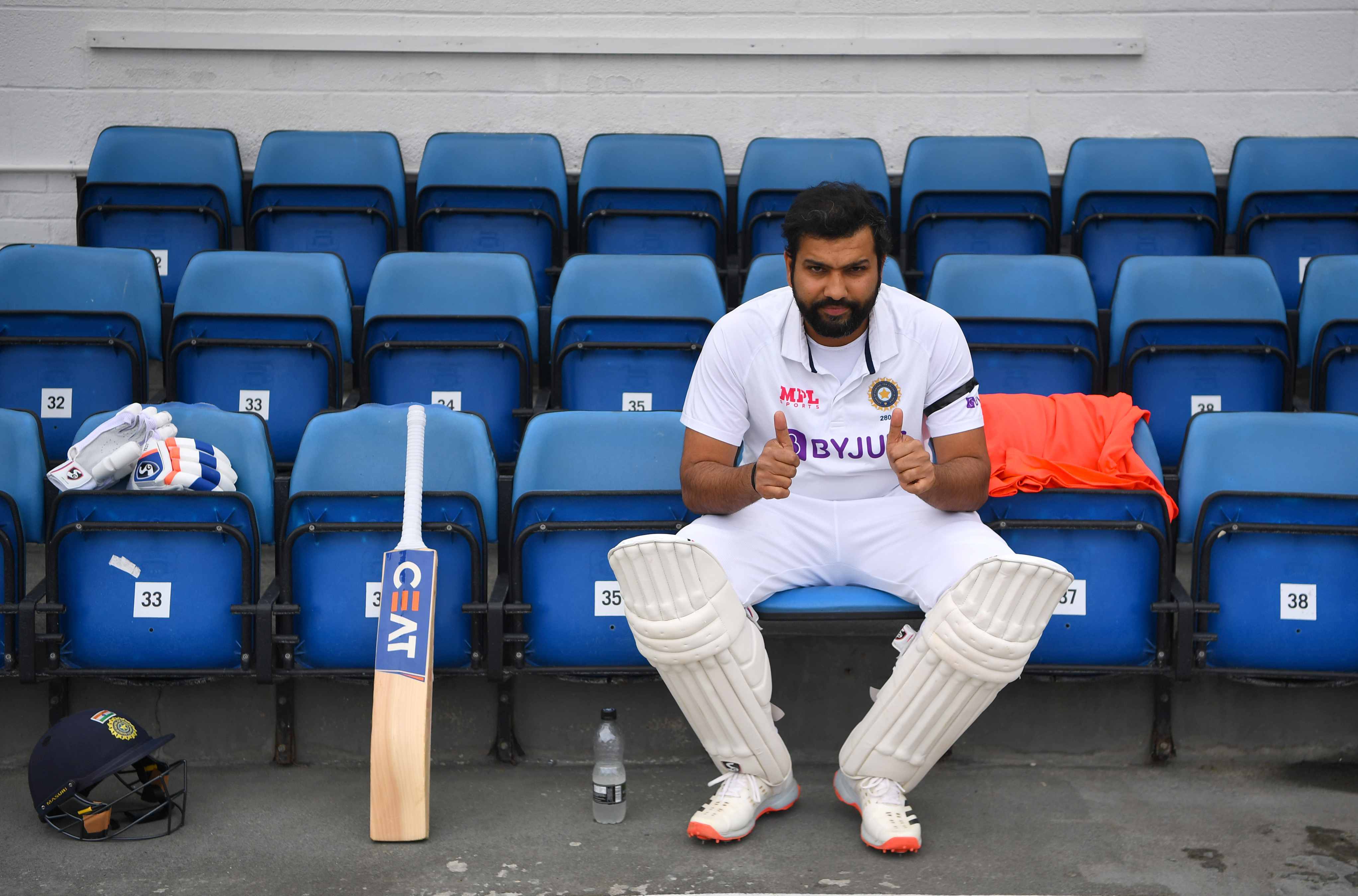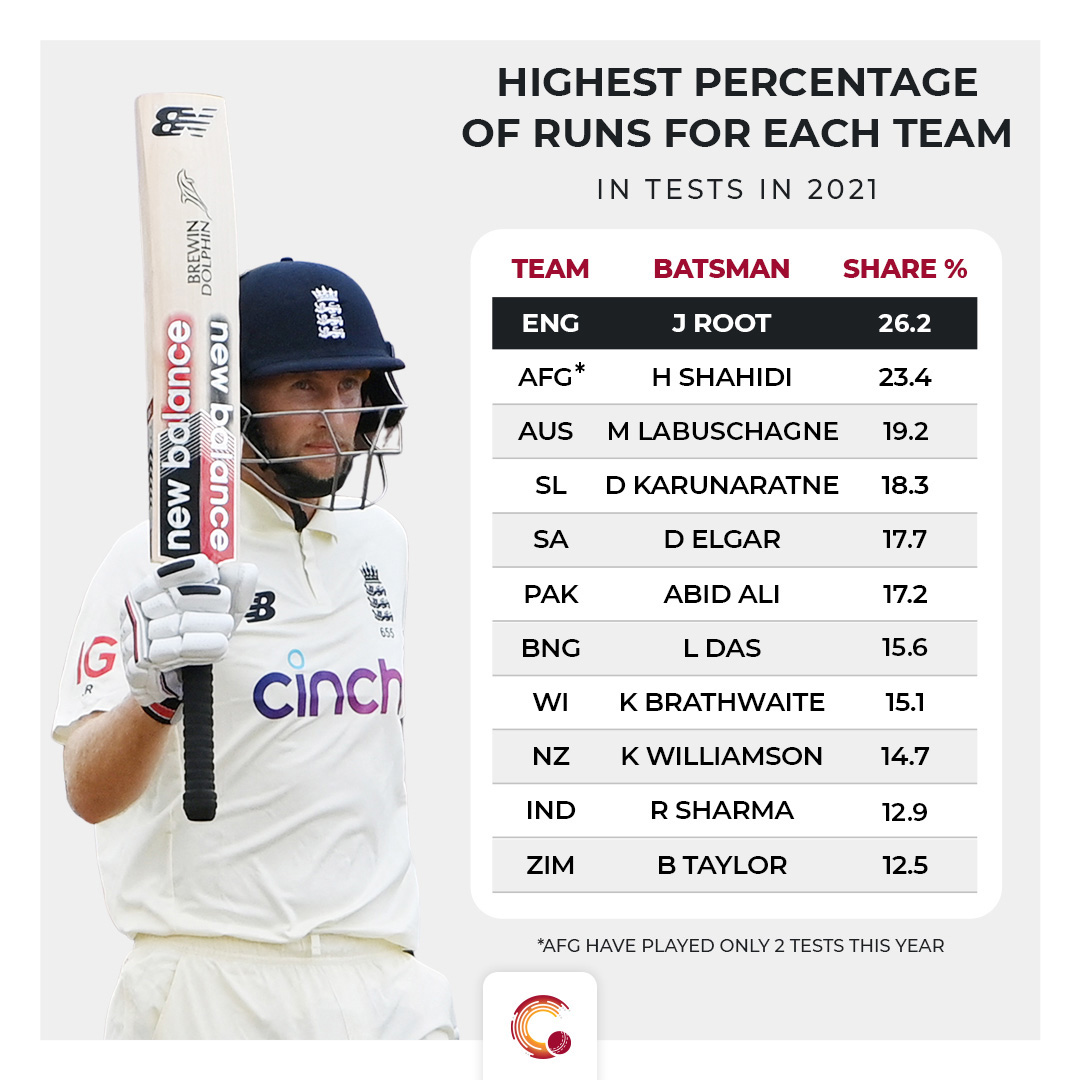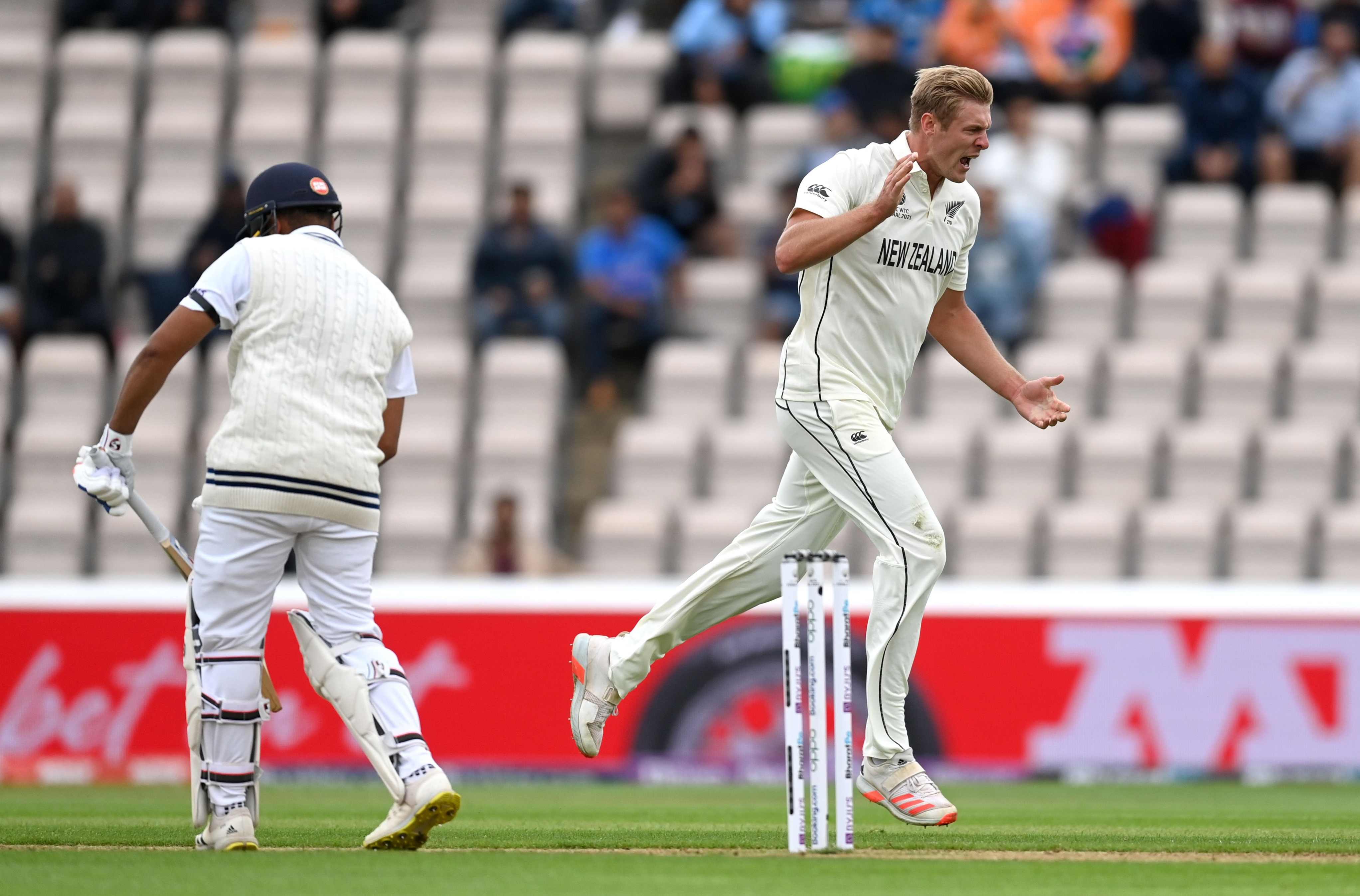News
Test Team of the Year, 2021
 TEST XI OF 2021
TEST XI OF 2021Here is an XI acknowledging the best performers in Test cricket this year
Test cricket took us on a crazy ride in 2021. Consisting of some memorable results, jaw-dropping moments and resilient individual performances, it had something for everybody. A number of players stood head and shoulders above the rest and it reflects in our Test XI of the Year. Most of these inclusions were straightforward while the others leapfrogged their contemporaries on account of team balance.
Rohit Sharma
(Innings 21, Runs 906, Average 47.7, 50s/100s 4/2)
Rohit Sharma began his year with a couple of tame dismissals in Sydney. It inevitably raised questions on his relevance in Test cricket for the umpteenth time. What panned out later was an eye opener for the cricket world. In a make or break year, Rohit scored 906 runs, the most for an opener in a calendar year since 2018, the year when Test averages dipped universally.
 It's not only the runs but the quality of them. On a Chepauk turner, he scored a dominating 161, contributing nearly 50 percent to the team’s total of 329. Opening in the polar opposite conditions in England, Rohit scored 368 runs at an average of 52.6. It was a masterclass on batting in England, from an overseas batter opening for the first time in one of the toughest countries to open. Rohit thus ticked the final box in his versatility index. It is unfortunate that he is missing the Tests in South Africa. But from question marks on his Test prospects, he has ended his year as the vice-captain of the Test side and the highest-ranked Indian batsman in Test cricket - fifth. All that, despite playing 11 Tests across contrasting conditions.
It's not only the runs but the quality of them. On a Chepauk turner, he scored a dominating 161, contributing nearly 50 percent to the team’s total of 329. Opening in the polar opposite conditions in England, Rohit scored 368 runs at an average of 52.6. It was a masterclass on batting in England, from an overseas batter opening for the first time in one of the toughest countries to open. Rohit thus ticked the final box in his versatility index. It is unfortunate that he is missing the Tests in South Africa. But from question marks on his Test prospects, he has ended his year as the vice-captain of the Test side and the highest-ranked Indian batsman in Test cricket - fifth. All that, despite playing 11 Tests across contrasting conditions.
Dimuth Karunaratne (c)
(Innings 13, Runs 902, Average 69.9, 50s/100s 3/4)
With four hundreds in only seven Tests, Dimuth Karunaratne is the obvious choice to partner Rohit in the Test XI of 2021. Akin to Rohit, Karunaratne has also stood the test of varying conditions - scoring vital runs in South Africa, West Indies and on home tracks of Sri Lanka.
While his 103 in Johannesburg came against a high-quality Protea pace unit in a defeat, his 118 and 147 laid the platform for comprehensive wins against Bangladesh and West Indies. Prior to that, he mustered the Bangladeshi bowlers for 244 runs in Pallekele, the highest Test score of the year. It was a flat track but the southpaw ensured an easy draw after the visitors posted 541 runs in their first innings. During this phase, he amassed six consecutive 50-plus scores.
Having not lost a complete Test series this year, Karunaratne is also elected as the captain of this side.
Marnus Labuschagne
(Innings 9, Runs 526, Average 65.8, 50s/100s 4/2)
Marnus Labuschagne has ended 2021 clinching the number one ranking for the first time in his career. Although he played all his five Tests at home, Australia was not an easy host country to bat this year - a batting average of 29.1.
In addition, Labuschagne was the highest run-scorer for Australia, contributing to 19.3 percent of their total runs this year. Only twice he was out under 50, scoring four fifties and two centuries. Barring the Boxing Day Test, his four first-innings scores read 91, 108, 74, 103.
Yes, he received the rub of the green with a number of dropped catches but no other number batsman at three averages higher than him (more than one Test). Labuschagne beats Kane Williamson to be the number three batsman in this XI.
Joe Root
(Innings 29, Runs 1708, Average 61, 50s/100s 4/6)
Joe Root had a bittersweet year which is a narrative on its own. On the personal front, he scored a whopping 1708 runs, the third-highest in a year in Test cricket’s history. He rose above the criticism of not scoring enough hundreds and notched up six of them. Four of these knocks were 180 or above including two double hundreds. He stood up against both spin and pace.

However, very little of it translated in results for his team as England lost series against India, New Zealand and Australia. Root still did everything in his ability to hold England’s batting together, contributing to 26.2 percent of their runs, a ridiculously high share. He will rue not getting to that elusive ton in Australia yet but given his tenacity, he is the undisputed number four in this side. He doesn’t get the captaincy though given he was ordinary in that role.
Fawad Alam
(Innings 13, Runs 571, Average 57.1, 50s/100s 3/2)
Fawad Alam had to endure a decade-long wait for a second crack in Test cricket but an average of 57.1 in 2021 will certainly give him a longer run. In fact, he walks in to this XI as effortlessly as he twirls his moustache.
Fawad’s perseverance has helped Pakistan stabilize their mercurial middle-order. His presence has often blocked the opponent’s path to run deep in Pakistan’s batting-order too quickly and we are not talking about his open chested stance figuratively. Facing South Africa in Rawalpindi, Fawad’s 109 helped Pakistan recover from 121/5 to a total of 378. His unbeaten 124 in Jamaica was critical in their series-leveling win in the Caribbean. He also cashed in against Zimbabwe with a knock of 140. Fawad has cleared his intentions of making up for the lost time and has been on the right track in 2021.
Dhananjaya de Silva
(Innings 10, Runs 530, Average 58.9, 50s/100s 2/2)
With the numbers mentioned above, Dhananjaya de Silva doesn’t have any competition as the number six in this line-up. He has been a stalwart for Sri Lanka at number five, scoring two hundreds and two fifties. The second hundred - an unbeaten 155 in Galle - took the game away from West Indies’ grasp. De Silva forged a 124-run stand for the ninth wicket where he contributed 75 runs.
Rishabh Pant (wk)
(Innings 21, Runs 748, Average 39.4, 50s/100s 5/1)
The 2020/21 Border Gavaskar Trophy started with Rishabh Pant warming the bench. It ended with him etching his name in the history books. His 97 in Sydney and 89* at Gabba pulled off historic results. The fact that he did it by giving Australia a taste of their own dish which they often served to the opposition in the form of Adam Gilchrist was a cherry on the cake.
Pant didn’t stop there. He teed off against England at home. After 91 and 58* in Chennai, his savage 101 in Ahmedabad broke England’s spirits. A ramp shot facing James Anderson with a new ball stunned everyone who watch it live.
Pant struggled in the second half of the year but has done enough to outshine Mohammad Rizwan, Quinton de Kock and Liton Das to be picked as the wicketkeeping-batsman in this XI. All the names mentioned here have a wicketkeeping efficiency in the range of 80 to 90 percent this year.
Ravichandran Ashwin
(54 wickets, Bowling Average 16.6, 5Ws 3, Runs 337, Batting average 25.4)
The highest wicket-taker in Test cricket this year, Ashwin won the player-of-the-series award in both assignments at home. He missed five of India’s seven overseas Tests this year but such was the enormity of his performances at home, he is an obvious pick in this XI. He pocketed 46 wickets in six Tests in India at only 13.7 apiece. He has been mayhem for the left-handers.
With his 106 in Chennai, he levelled with Sir Ian Botham as only the second all-rounder to amass a hundred and a five-for in the same Test more than twice. That ton was not even Ashwin’s best performance with the bat this year. The recognition will go to his rearguard action in Sydney. Ashwin batted over two hours with a broken back to salvage a famous draw alongside Hanuma Vihari. No doubt he is the prime all-rounder in this side.
Kyle Jamieson
(27 wickets, Bowling Average 17.5, Bowling Strike-Rate 41.5, 5Ws 3)
You won’t see Kyle Jamieson in the list of top 10 wicket-takers this year but 27 scalps at 17.5 runs per wicket is a special effort. 23 of these victims were from the top seven batting positions, highlighting his quality further.

After a grand entry to Test cricket in 2020, he began his 2021 with an 11-wicket haul against Pakistan, including his current career-best of 6/48. In one of the biggest bowling performances of the year, Jamieson’s 5/31 in Southampton crowned New Zealand as the maiden World Test Championship winners.
The only question left was if Jamieson can pick wickets on the dusty tracks of the Indian subcontinent. He answered them quite convincingly with a three-wicket haul in each innings of the Kanpur Test. His batting provides depth to this side.
Shaheen Afridi
(47 wickets, Bowling Average 17.1, Bowling Strike-Rate 37.4, 5Ws 3)
Shaheen Shah Afridi gets into the team as the second-highest wicket-taker of 2021. 17 of his 47 scalps were of the top three batsmen which underlines how well he performed his role as a strike bowler. Yes, a couple of Tests against Zimbabwe boosts his numbers but even if you remove them, Shaheen pips the likes of Tim Southee, James Anderson, Ollie Robinson, Anrich Nortje and Hasan Ali.
Pace, bounce, control, aggression, the southpaw has shown every trait of fast bowling this year. He takes the new ball in our XI.
Jasprit Bumrah
(30 wickets, Bowling Average 26.5, Bowling Strike-Rate 61.7, 5Ws 1)
Bumrah’s numbers don’t put him in the league of Jamieson and Afridi. He was also outbowled by a few other candidates for the third seamer’s role. Anderson had better numbers in the series in India. Mohammad Shami and Mohammad Siraj had better figures than Bumrah on many occasions. However, it is the sheer quality of Bumrah’s wickets that has given him the green signal as the enforcer in the attack.
On paper, Bumrah picked only three wickets at Lord’s but he snared Joe Root at a critical moment in India’s surge towards a miraculous win. Later on, he trapped Ollie Robinson with a ball that is a story in its own. Going beyond the numbers again, his 2/27 at the Oval was probably the most impactful spell of the year. And again in Centurion, Bumrah opened the gates for India again with a ripping nip-backer to dismiss Rassie van der Dussen on Day 4. In addition, he has a five-wicket haul as well in Nottingham.

Given India’s vast success in whites, it is obvious this team has four Indians. There are also two players each from Pakistan and Sri Lanka. Beyond Asia, a representative each from England, Australia and New Zealand complete the XI. The side is rich with both batting and bowling resources. Unintentionally, everyone in the middle-order can roll their arm over. The batting runs deep till number nine.